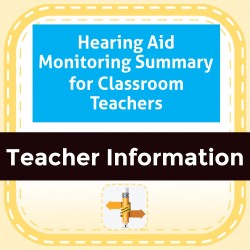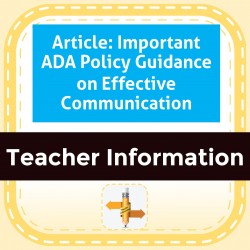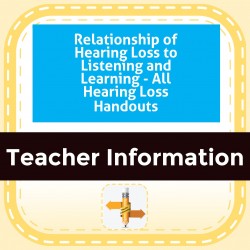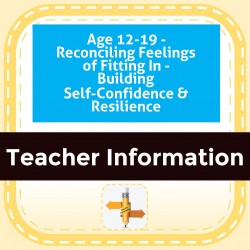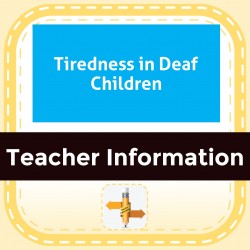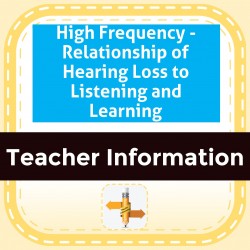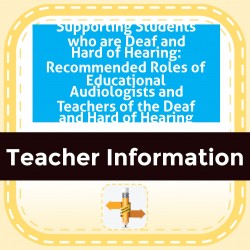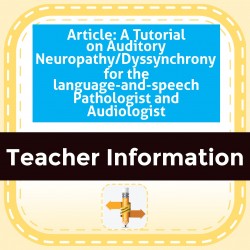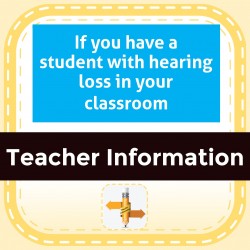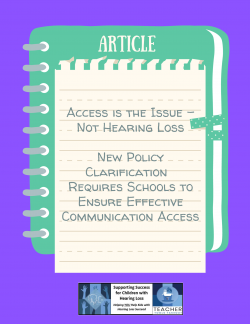Ability Levels
Categories
Resource Types
Age/Grade Range
CCSS
Anchor Standard
Speaking & Listening
Language
Reading
Hearing Aid Monitoring Summary for Classroom Teachers
$ 095
This handout is a summary of hearing aid monitoring for classroom teachers. It answers the why, when, and how of hearing aid listening checks. Pair with a handout describing performing the Ling Sound
...
check P01TEA0472
Article: Important ADA Policy Guidance on Effective Communication
$ 0
This article provides background information on the requirements of IDEA, Section 504, and Title II of the ADA that require supports and services for eligible students with hearing loss. It describes
...
the meaning of effective communication under Title II of the ADA and implications for schools. By Cheryl DeConde Johnson.
Relationship of Hearing Loss to Listening and Learning - All Hearing Loss Handouts
$ 0
Handout with information on possible impact on understanding language, speECH-, social, and need for educational accommodations and services. Handouts for 9 hearing loss degrees/type.
Age 12-19 - Reconciling Feelings of Fitting In - Building Self-Confidence & Resilience
$ 250
For ages 12-19 years: This information addresses feelings of fitting in, problem-solving, social isolation, identity, importance of role models, positive outlook, and dealing with challenges due to he
...
aring loss. The purpose of this book is to raise awareness for the reasons why hearing device rejection happens and specific instruction to occur at different ages to build student resilience and self-confidence, thereby increasing the likelihood that they will not reject using their hearing technology. Specific teaching activities and recommendations for instructional materials to develop identified skills have been included in this Guide.
Tiredness in Deaf Children
$ 0
Information for parents and educators about the impact of hearing loss on a child's level of energy. Extra focus required to listen in a classroom with a hearing loss often results in higher levels of
...
fatigue and the need to take listening breaks. Includes tiPS- for dealing with fatigue.
High Frequency - Relationship of Hearing Loss to Listening and Learning
$ 0
Handout with information on possible impact on understanding language, speECH-, social, and need for educational accommodations and services. For high-frequency hearing loss.
Supporting Students who are Deaf and Hard of Hearing: Recommended Roles of Educational Audiologists and Teachers of the Deaf and Hard of Hearing
$ 0
This information compares the role of educational audiologists and teachers of the deaf/hard of hearing in providing services and supports to students with hearing loss. From Educational Audiology Ass
...
ociation.
Article: A Tutorial on Auditory Neuropathy/Dyssynchrony for the Speech Language Pathologist and Audiologist
$ 0
This article presents inforamtion about developmental outcomes of children with auditory neuropahty, auditory dyssynchorny. It also provides information about etiologies and audiological information o
...
f children with AN. It includes assessment tools that have been useful in decision making for children with AN.
If you have a student with hearing loss in your classroom
$ 2
Summary of accommodations needed by students with hearing loss in the classroom. 8 catchy phrases help to make the accommodations more memorable to school staff.
Article: Access is the Issue, Not Hearing Loss - New Policy Clarification Requires Schools to Ensure Effective Communication Access
$ 0
Information in this article is presented to assist the educational audiologist, teacher of the deaf/hard of hearing, or speECH--language pathologist in demonstrating the impact of hearing loss on acce
...
ss to classroom communication so that the ADA question “Does this student have effective access to communication in school?” can be answered in an evidence-based manner. By Karen Anderson.
 Your browser is out of date. For best experience switch to latest updated Browser.
Your browser is out of date. For best experience switch to latest updated Browser.
 Get Chrome
Get Chrome Get Edge
Get Edge Get Firefox
Get Firefox